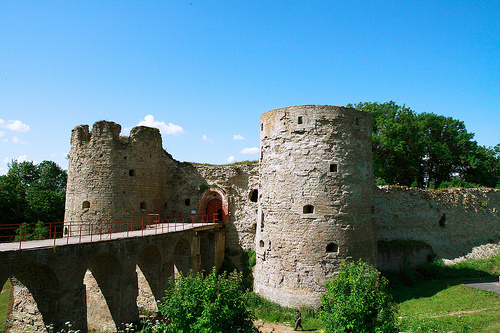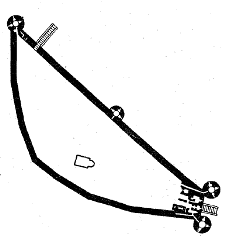

Location: 100 km (62 mi) West of St. Petersburg, Leningrad oblast Map
Constructed: 13th century

Koporye Fortress is a medieval citadel situated 100 km (62 mi) West of St. Petersburg, Leningrad oblast of Russia. It is one of the few Russian medieval citadels that were found outside of large settlement and cities. Russians often were attacked by nations from the South and East who didn't share their Christian faith and hence they couldn't expect nobility or honor in the treatment of prisoners in case of loss. Hence there were very few private castles as it was in the rest of Europe. Collective protection against outside enemy shaped people's mentality and culture for centuries until modern day.
The fortress in Koporye was founded in 1237. It was first mentioned
in the Novgorod chronicles in 1240, when the German knights of the
Livonian Order built a wooden fortress in the Koporsky churchyard.
In
1241, Alexander Nevsky recaptured the fortress from the German knights
and destroyed it. During the assault, the famous hero Gavrila Aleksich
died. Sofia First Chronicle:
In the same summer, after the return,
the victory of the great Alexander Yaroslavich, the same winter packs
came from the Western country of Nemtsi and Chud to Vod. And you fought
everything, and laid tribute on them, and cut down the city in Koporia
in the fatherland of the Grand Duke Alexander Yaroslavich. <...> That
same summer, Prince Oleksandr went to the Germans, to the city of
Koporye, from Novgorod and took the city, and the Germans brought to
Novgorod.
In 1280, Grand Duke Dmitry Alexandrovich set up a stone
city in Koporye, which two years later was destroyed by the Novgorodians
as a result of a conflict with the prince. The fortress was built again
in 1297, and at the end of the 15th - beginning of the 16th century it
was rebuilt.
In 1565, when Tsar Ivan the Terrible divided the
Russian state into oprichnina and zemshchina, Koporskaya fortress became
part of the latter.
After the capture by the Swedes in 1581,
Koporye returned to Russia only under the treaty of 1590.
However, according to the Stolbovsky Peace of 1617, Koporye again went
to Sweden. In 1656-1657, the Russian army unsuccessfully tried to return
Koporye, which was returned to Russia only under Peter I, in 1703.
In 1708, Peter I handed over the fortress to Prince Menshikov, and
in 1727, after his disgrace, Koporye passed into the treasury. In 1763,
the Koporye fortress was excluded from the list of defensive structures.
In 1919, during the Civil War, the soldiers of the Red Army, using
the fortress, successfully repelled the attack of the White Guards
landing behind the lines of the Red Army.
On October 23, 1919,
soldiers of the 6th Talab Infantry Regiment of the 2nd Infantry Division
of the Northwestern Army counterattacked the village and fortress of
Koporye, occupied by the 6th Division of the 7th Red Army.
In
August 1941, Soviet troops fought fierce battles with the Nazi invaders
near Koporye, but on September 1 they were forced to retreat. Having
entrenched 12 kilometers from the ancient fortress, on the Voronka
River, units of the Red Army blocked the way for the enemies. In January
1944, Koporye was liberated.
In 1962, the fortress church burned
down from an accidental fire.
In 2001, the fortress received the
status of a museum.
On April 7, 2013, the fortress was officially
closed to the public due to an emergency condition.
In 2015, an
agreement was signed between the Federal Property Management Agency and
the Committee of Culture of the Leningrad Region on the transfer of the
fortress to the gratuitous, perpetual use of the museum agency of the
region.
In 2018-2019, preliminary scientific research and
archaeological excavations were carried out, then a competition was
announced for the design of the most dangerous part: the entrance area,
adjacent towers and the wall. The design completion date is December 1,
2020. A competition for restoration work on this project is scheduled
for 2021. As of March 2020, due to the recent collapse of the arch of
the main entrance of the fortress, urgent emergency work is required;
The fortress is open with limited visits.
The fortress includes:
defensive walls
gate
complex
Bridge, the last part of which used to be a lift
Church of
the Transfiguration
Chapel, family tomb of the Zinovievs
The
"soldiers' apartments", the food warehouse, the stable, the command
chamber and the people's quarters have not survived to this day.
fortress towers
north tower
south tower
Middle tower
Naugolnaya tower